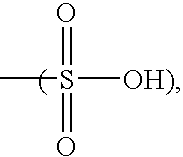Molecular complexes and release agents
a technology applied in the field of molecular complexes and release agents, can solve the problems of unfavorable toner offset, interference with the operation of the electrostatographic apparatus and the quality of the final product of the electrostatographic process, and undesired additional interaction with other components, so as to improve the wetting of toner surfaces, improve the wetting of fluorocarbon surfaces, and reduce the effect of toner offs
- Summary
- Abstract
- Description
- Claims
- Application Information
AI Technical Summary
Benefits of technology
Problems solved by technology
Method used
Image
Examples
example 1
[0276]2.606 grams of PS513b and 0.13 grams of stearic acid were combined and melt blended, at a temperature of from about 80° C. to about 90° C., to form a clear liquid. On cooling, the liquid remained clear for about 10 minutes, then a haze slowly developed, and the liquid solidified to a semisolid. The semisolid remelted at 50–55° C., significantly below the previously observed stearic acid melting point of about 80° C.
example 2
[0277]5 grams of PS510a and 1 gram of stearic acid were combined and heated at 80° C. for several minutes, and the product was subjected to Fourier transform infrared spectroscopy (IR). Infrared spectroscopy of the functional groups was used to determine the state of the reaction; the spectroscopy showed the disappearance of the stearic acid peak at 1700.
[0278]The foregoing reaction and analysis were repeated, but with an excess of stearic acid; specifically, 5 grams of PS510a and 1.5 grams of stearic acid were employed. Here, a small stearic acid peak at 1700 was observed. However, the spectra of the relevant compounds—i.e., the acid and amine reactants, and the prospective product—were difficult to observe, due to the high molecular weight of the PS510a, and the resulting low concentration of the compounds' functional groups. Therefore, in place of PS510a, octadecylamine—with a much lower molecular weight, and therefore a higher amine concentration—was employed as a model amine, a...
example 3
[0281]0.81 grams of stearic acid and 40 grams of PS513b were combined and heated to about 80–85° C., with stirring, until melt blended, about 30 minutes total preparation time. No precipitation of the stearic acid was observed on cooling. 17.6 grams of the product were combined with 382.4 grams of 60,000 cSt DC200® oil, and blended at room temperature.
PUM
| Property | Measurement | Unit |
|---|---|---|
| Temperature | aaaaa | aaaaa |
| Temperature | aaaaa | aaaaa |
| Fraction | aaaaa | aaaaa |
Abstract
Description
Claims
Application Information
 Login to View More
Login to View More - R&D
- Intellectual Property
- Life Sciences
- Materials
- Tech Scout
- Unparalleled Data Quality
- Higher Quality Content
- 60% Fewer Hallucinations
Browse by: Latest US Patents, China's latest patents, Technical Efficacy Thesaurus, Application Domain, Technology Topic, Popular Technical Reports.
© 2025 PatSnap. All rights reserved.Legal|Privacy policy|Modern Slavery Act Transparency Statement|Sitemap|About US| Contact US: help@patsnap.com



